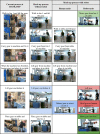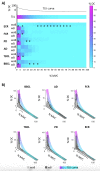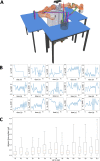Interdisciplinary evaluation of a robot physically collaborating with workers
- PMID: 37819889
- PMCID: PMC10566690
- DOI: 10.1371/journal.pone.0291410
Interdisciplinary evaluation of a robot physically collaborating with workers
Abstract
Collaborative Robots-CoBots-are emerging as a promising technological aid for workers. To date, most CoBots merely share their workspace or collaborate without contact, with their human partners. We claim that robots would be much more beneficial if they physically collaborated with the worker, on high payload tasks. To move high payloads, while remaining safe, the robot should use two or more lightweight arms. In this work, we address the following question: to what extent can robots help workers in physical human-robot collaboration tasks? To find an answer, we have gathered an interdisciplinary group, spanning from an industrial end user to cognitive ergonomists, and including biomechanicians and roboticists. We drew inspiration from an industrial process realized repetitively by workers of the SME HANKAMP (Netherlands). Eleven participants replicated the process, without and with the help of a robot. During the task, we monitored the participants' biomechanical activity. After the task, the participants completed a survey with usability and acceptability measures; seven workers of the SME completed the same survey. The results of our research are the following. First, by applying-for the first time in collaborative robotics-Potvin's method, we show that the robot substantially reduces the participants' muscular effort. Second: we design and present an unprecedented method for measuring the robot reliability and reproducibility in collaborative scenarios. Third: by correlating the worker's effort with the power measured by the robot, we show that the two agents act in energetic synergy. Fourth: the participant's increasing level of experience with robots shifts his/her focus from the robot's overall functionality towards finer expectations. Last but not least: workers and participants are willing to work with the robot and think it is useful.
Copyright: © 2023 Cherubini et al. This is an open access article distributed under the terms of the Creative Commons Attribution License, which permits unrestricted use, distribution, and reproduction in any medium, provided the original author and source are credited.
Conflict of interest statement
The authors have declared that no competing interests exist.
Figures








References
-
- Colgate J. E., Wannasuphoprasit W., Peshkin M. A. Cobots: Robots for collaboration with human operators. Proc. of ASME IMECE, 1996.
-
- Peshkin M. A., Colgate J. E., Wannasuphoprasit W., Moore C. A., Gillespie R. B., Akella P., CoBot architecture. IEEE Trans. Robot. Autom. 17(4), 377–390, 2001.
-
- Cherubini A., Passama R., Crosnier A., Lasnier A., Fraisse P. Collaborative manufacturing with physical human–robot interaction, Robotics and Computer-Integrated Manufacturing, 40 pp. 1–13, 2016.
Publication types
MeSH terms
LinkOut - more resources
Full Text Sources

